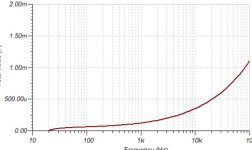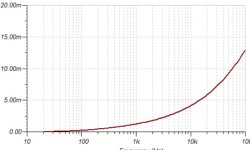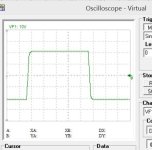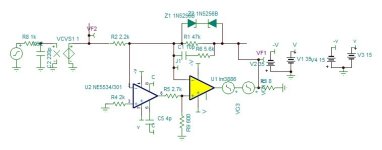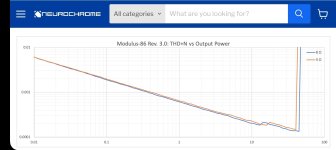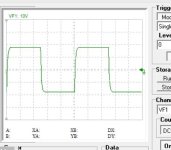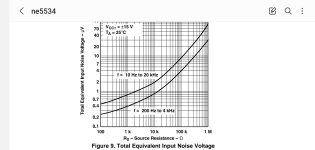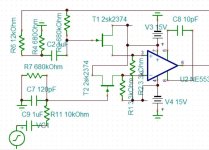H
HAYK
I knew the lm3886 from a Thai AV amp that sounded exceptional high frequency character. This why I suppose it is used as tweeter amp in amplified speakers as Focal,JBL. This character dissappear when mounted in bridge or in composite. With this corrector, I could adjust so that the Requiems get clean all preserving this fine character. In other words, it is not the lowest distortion number makes lm3886 sing its best.
I'll record several extracts later showing this fine sound.
I'll record several extracts later showing this fine sound.
H
HAYK
These are two most difficult songs to reproduce. The My Way of Frank is wave format the B.Manilow's "I can't smile without you"in MP3 you can find on YouTube.
I submitted to Wolverine built thread the Frank's song it didn't pass, why? According to the designer it is recorded with bad microphone. The requiem of Mozart didn't neither, why, because of dirty MP3. As one can see, it is not because you have dazzling number of zeros in the THD number that makes it sound clean.
I submitted to Wolverine built thread the Frank's song it didn't pass, why? According to the designer it is recorded with bad microphone. The requiem of Mozart didn't neither, why, because of dirty MP3. As one can see, it is not because you have dazzling number of zeros in the THD number that makes it sound clean.
Attachments
Last edited by a moderator:
hi hayk,
"it is not the lowest distortion number makes lm3886 sing its best."
what are the numbers? like thd for 1 watt - 25watt etc, and if you have also thd for different harmonics
you use a video opamp, can other opamps be used and do you know what influence the opamp has on the overall sound?
"it is not the lowest distortion number makes lm3886 sing its best."
what are the numbers? like thd for 1 watt - 25watt etc, and if you have also thd for different harmonics
you use a video opamp, can other opamps be used and do you know what influence the opamp has on the overall sound?
H
HAYK
The PCB plays a big role in THD numbers, for now I need to get best sounding circuit, numbers comes as result in the final stage, as showing the X rays of elected Miss Universe.
I want to remind that I am using 106db 2way speaker. 9x12" 100db woofers above 230hz, giant horn. By this, the amp is working in its worst range of crossover distortion.
The opamp is used as differential amp with adjustable gain and bandwidth, I don't know any equivalent to AD829, if you know, give a hint. The AD829 I am using is not original but performs very good.
I want to remind that I am using 106db 2way speaker. 9x12" 100db woofers above 230hz, giant horn. By this, the amp is working in its worst range of crossover distortion.
The opamp is used as differential amp with adjustable gain and bandwidth, I don't know any equivalent to AD829, if you know, give a hint. The AD829 I am using is not original but performs very good.
H
HAYK
It is possible with Yewen corrector to use the jellybean NE5534 (4pf is necessary for simulation to model the opamp without extra compensation)
I need to find a jfet input very low THD+N opamp as input buffer that doesn't cost an arm. The OPA I am using have offset problem to resolve.
I need to find a jfet input very low THD+N opamp as input buffer that doesn't cost an arm. The OPA I am using have offset problem to resolve.
Attachments
H
HAYK
Do you know the THD+N @1W of Modulus86?hi hayk,
"it is not the lowest distortion number makes lm3886 sing its best."
what are the numbers? like thd for 1 watt - 25watt etc, and if you have also thd for different harmonics
you use a video opamp, can other opamps be used and do you know what influence the opamp has on the overall sound?
With Yewen as I need an input buffer, the THD+N of the amplifier will be that of the buffer. With a gain of 20, for 1W, the buffer must output 140mv rms. If I use an expensive jfet opamp costing about $5, the THD+N will not be less than 0.0006%. With OPA1632 is about half of it but needs a servo or manual offset adjust.
Attachments
H
HAYK
I tried the Yewen version. The OPA1632 can't work without feedback on the positive input. In other words it can't be used as differential output buffer. I switched to NE5532 as unity non inverting follower. This time I had hard time to struggle with the output offset. I could bring within 100mv to hear the sound.
Very disappointing, the grandiose sound got replaced with a mean greedy one although clean but very uninteresting to listen to. It is miles away to bring it to high quality grade.
I will leave it for now and restart with NE5532 and servo with a good buffer maybe OPA827.
Very disappointing, the grandiose sound got replaced with a mean greedy one although clean but very uninteresting to listen to. It is miles away to bring it to high quality grade.
I will leave it for now and restart with NE5532 and servo with a good buffer maybe OPA827.
H
HAYK
I replaced the AD829 with NE5534, it has -86db NFB@20KHZ. I will make a seperate model to compare them. This circuit is the simplest and most promising.
If someone can suggest other low noise opamps with compensation possible I'll try it.

If someone can suggest other low noise opamps with compensation possible I'll try it.
Attachments
H
HAYK
I wired it with ne5534, it needed only 5pf parallel to 120k R1 to be stable. Although I have very low gain , wiring fault, the sound is very clean, vivid, and particularly agreeable to listen.
I will keep this configuration and start from new with magnetic fields canceled to tune the sound correctly.
I will keep this configuration and start from new with magnetic fields canceled to tune the sound correctly.
Attachments
H
HAYK
The THD+N with such amp at low powers is mainly noise. If the extra NFB reduces that of the power opamp the noise of the corrector remains the main issue. The NE5534 has ultra low current noise, the graph vs input impedance shows the noise decrease by decrease of input impedance. To take advantage of this character, I will drive the inputs by an ultra low noise jfets the 2sk3557. The simulator model is not correctly modeled as the graph shows but 4 fold decrease is possible.
Attachments
H
HAYK
Using 2n7000 or BF862 gives the same noise as it is dominated by the 10k input resistor. But for sure the noise of the 5534 will decrease considerably as the output impedance of both transistors is 25 ohms with 10ma bias.
If I replace in the simulator the power opamp by a voltage multiplier, I get exactly the same noise, a proof that the nonlinearities of the power opamp are canceled. Unlike composite type the error corrector output is in mv range as it provides only adjustments, this why the distortion of the corrector itself is not important as is for the noise.
If I replace in the simulator the power opamp by a voltage multiplier, I get exactly the same noise, a proof that the nonlinearities of the power opamp are canceled. Unlike composite type the error corrector output is in mv range as it provides only adjustments, this why the distortion of the corrector itself is not important as is for the noise.
H
HAYK
The NE5534 needed an output MOSFET buffer which allows to run in classA and offer low impedance to the power feedback. The graph bellow shows relative output of the opamp to be less than -40db in the sound range. It needs less than 2Vp input to saturate hence 20mvp max is the error output.
To notice that unlike Modulus86 publicity, we don't have here a precision opamp controlling a les precision power opamp.

To notice that unlike Modulus86 publicity, we don't have here a precision opamp controlling a les precision power opamp.
Attachments
Last edited by a moderator:
H
HAYK
OPA1656 has high 1/f noise. Just compare input voltage noise graphs with e.g. OPA1612 or OPA2210 which are truly ultra-low noise.
H
HAYK
Opa1612 has very high current noise, opa2210 has the same current noise as 5534a but less voltage noise. With low impedance source 2210 and 5534a are nearly similar knowing that my 10k input resistance dominates the voltage noise
H
HAYK
Siliconix has an application note of 5534. Any one knows where to find?


Last edited by a moderator:
- Home
- Amplifiers
- Chip Amps
- Error Corrected Chip Amplifiers, aka Modulus Clone
